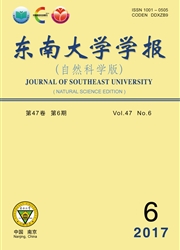

 中文摘要:
中文摘要:
针对在噪声环境中人的听觉认知机制研究中,频率跟随响应(FFR)分析方法受1/f噪声和工频干扰严重,且局限于包络频率跟随响应(FFRENV),不能直接而全面地反应锁相机制问题,提出了利用时域细节结构频率跟随响应(FFRTFS)信号的幅度谱信噪比和神经元锁相值(PLV)分析FFR的2种新方法.这2种方法均利用拔靴法和傅里叶变换估计出本底噪声以及锁相信息,并利用统计特性和零假设识别出显著有效响应.听觉认知脑电实验结果表明:2种方法均不受1/f噪声和工频影响;PLV方法计算量小,有效响应显著,能直观地体现锁相机制;在基频处,FFRENV的抗噪性好,在谐波处,FFRTFS抗噪性好;在相同环境下,不同的刺激声音频率对FFRENV和FFRTFS的作用不同.以上结论有助于提高听力损伤人群在日常生活中的听觉认知及语言交流能力.
 英文摘要:
英文摘要:
The human auditory cognitive mechanisms in noisy environments are studied. Existing frequency following response (FFR) analysis methods are seriously influenced by 1/f noise and power frequency, and restricted to envelope-related frequency following response ( FFR_ENV ), making it unable to reflect the phase locking mechanism directly and comprehensively. To overcome these shortcomings, two approaches are proposed for analyzing FFR: amplitude spectrum signal-to-noise ratio and phasing locking value (PLV) of temporal fine structure-related FFR( FFR_TFS ). Both of the two utilize the bootstrap method and the Fourier transform to estimate the ground noise and phase- locking information, and recognize the significantly effective response by statistics and zero hypothe- sis. Electroencephalographic auditory cognition experimental results show that the performances of the two approaches are not affected by either 1/f noise or power frequency. In addition, the PLV method has a low computational complexity with remarkable effective response, and thus it can re- flect the phase locking mechanism directly. At the fundamental frequency, FFRENv is robust to addi- tive noises, while at the harmonic frequencies, FFRTFs is robust to additive noises. Under the same environment, frequencies of sources have distinct contributions to FFRENvand FFRTFs. These conclu- sions are assumed to enhance the hearing impaired person's capabilities of auditory cognition and ver- bal communication in daily life.
 同期刊论文项目
同期刊论文项目
 同项目期刊论文
同项目期刊论文
 期刊信息
期刊信息
